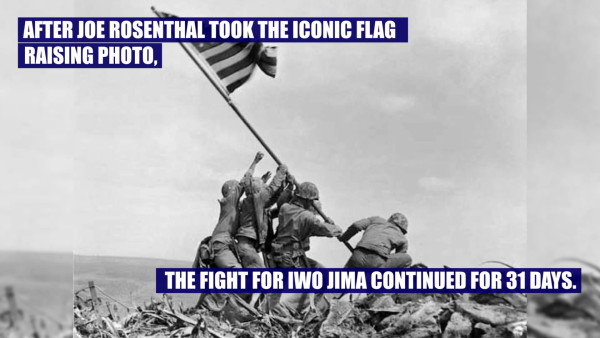

More than 74 years after Marines raised the American flag on Mount Suribachi, Iwo Jima, the Marine Corps has announced that one of men in the most famous picture of World War II had been misidentified.
“Originally, Private First Class Rene A. Gagnon was identified as the Marine pictured on the far side of the flagpole, with only his helmet visible,” the Corps announced on Thursday. “With the assistance of historians, new evidence and modern technology, it was determined that Pfc. Rene A. Gagnon contributed to the flag raising, but is not actually pictured in the photograph.”
“Instead, Corporal Harold P. Keller has been identified as the Marine located on the far side of the flagpole,” the Corps said in a statement.

In this Feb 23, 1945 file photo, U.S. Marines of the 28th Regiment, 5th Division, raise the American flag atop Mt. Suribachi, Iwo Jima, Japan. (Associated Press/Joe Rosenthal)
NBC News first reported on Wednesday that historians were able to identify Keller in the photograph by analyzing pictures taken by other service members at Mount Suribachi. Investigators with the FBI’s Digital Evidence Laboratory confirmed their findings.
“Private First Class Gagnon played a significant role in the flag raising on Mount Suribachi and his role will never be diminished,” the Marine Corps statement said. “He was directly responsible for getting the larger second flag to the top and returning the first flag for safekeeping. Without his efforts, this historical event might not have been captured, let alone even occurred.”
This is the second time since 2016 that the Marine Corps has announced that one of the men photographed by Joe Rosenthal of the Associated Press had been misidentified. Three years ago, the Corps determined that Pvt. 1st Class Harold Schultz, not Navy Corpsman John Bradley, was one of the six men in the picture.
“Regardless of who was in the photograph, each and every Marine who set foot on Iwo Jima, or supported the effort from the sea and air around the island is, and always will be, a part of our Corps’ cherished history,” the Marine Corps statement says. “In the words of General David H. Berger, Commandant of the Marine Corps, ‘They are all heroes.'”
Read the entire Marine Corps statement below:
Correction to the Identity of Marines in Photograph of the Flag Raising on Mount Suribachi, Iwo Jima
The correct identification of Marines in Mr. Joe Rosenthal’s iconic photograph of the second flag raising on Mount Suribachi, Iwo Jima, Japan, is important. Following changes made in 2016 to the historical record of Rosenthal’s photograph, the Marine Corps continued to remain open to receiving new information that could provide further clarity. In July 2018, the Marine Corps was contacted by private historians who asserted that there was an error in identifying the Marines depicted in Rosenthal’s photo. These historians provided a significant amount of new evidence for consideration, mostly in the form of dozens of previously private photographs.
In order to ensure that its history was properly acknowledged and preserved, the Marine Corps formed a board, which considered the new evidence provided and sought the assistance of the Federal Bureau of Investigation (FBI) in assessing the contents of the photographs. The board deliberated on the claims that came from the presentation of new information.
Originally, Private First Class Rene A. Gagnon was identified as the Marine pictured on the far side of the flagpole, with only his helmet visible. With the assistance of historians, new evidence and modern technology, it was determined that Pfc. Rene A. Gagnon contributed to the flag raising, but is not actually pictured in the photograph. Instead, Corporal Harold P. Keller has been identified as the Marine located on the far side of the flagpole.
Without the initiative and contributions of both private historians devoted to preservation of our history and the FBI’s support, the Marine Corps would not have this opportunity to expand on the historical record of the second flag raising on Mount Suribachi. We are extremely grateful for their dedication to helping us preserve our legacy.
As a result of the board’s evaluation of the information provided, the Marine Corps accepted the change in the identification of the Marines pictured in the photograph as necessary in the historical documentation of Rosenthal’s photograph. The names associated with pictured individuals is the only change resulting from this board.
Regardless of who was in the photograph, each and every Marine who set foot on Iwo Jima, or supported the effort from the sea and air around the island is, and always will be, a part of our Corps’ cherished history. In the words of General David H. Berger, Commandant of the Marine Corps, “they are all heroes.”
Private First Class Gagnon played a significant role in the flag raising on Mount Suribachi and his role will never be diminished. He was directly responsible for getting the larger second flag to the top and returning the first flag for safe keeping. Without his efforts, this historical event might not have been captured, let alone even occurred.
The Marine Corps honors the “uncommon valor” that is the hallmark of all Marines who fought in the historic battle of Iwo Jima in World War II. We also honor the sacrifice of every Sailor, Soldier and Coast Guardsman who served there and the courage of their former adversaries. Iwo Jima is one of the few places on Earth that is the site of such a ferocious battle where former adversaries now come together as allies to remember and honor those whose sacrifices ultimately laid the foundation for peace and prosperity.